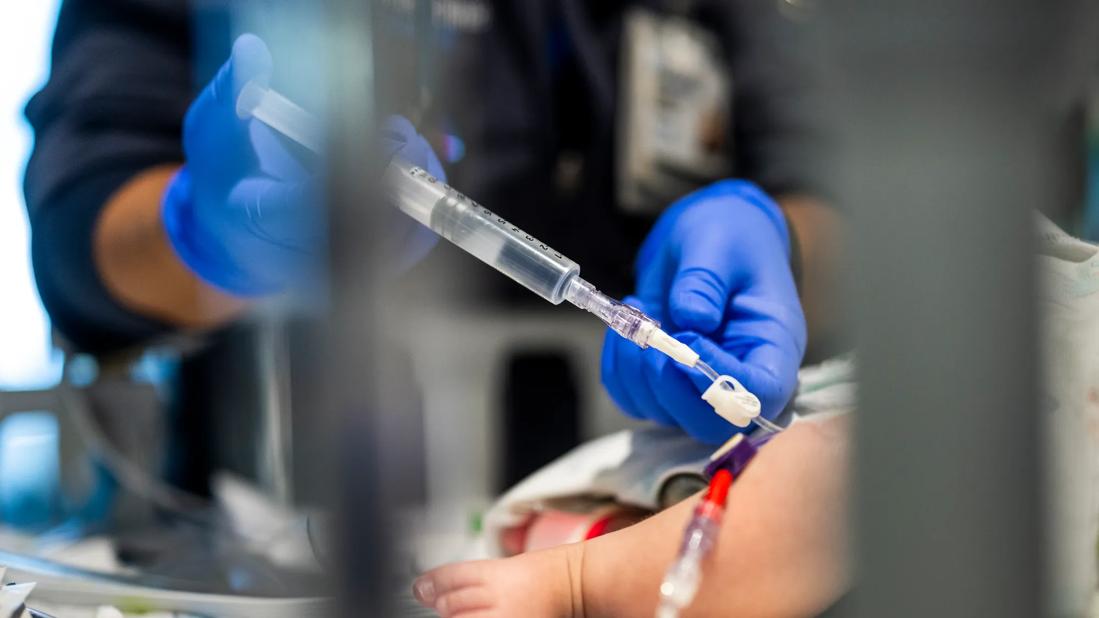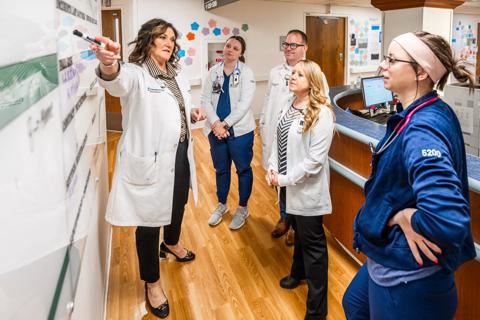SHINE program is seeing results

According to the Agency for Healthcare Research and Quality (AHRQ), nearly 50% of patients treated in an ICU receive indwelling central venous catheters, which equates to about 15 million central lines placed every year. Central venous catheters are associated with an increased risk for infection. The AHRQ reports that as many as 28,000 patients die annually from central-line associated bloodstream infections (CLABSI) in U.S. ICUs.
Advertisement
Cleveland Clinic is a non-profit academic medical center. Advertising on our site helps support our mission. We do not endorse non-Cleveland Clinic products or services. Policy
Hospital-acquired infections (HAIs) are a problem that all hospitals are trying to solve, and over the years Cleveland Clinic hospitals have implemented various safeguards to reduce them. Although the rate of infections have decreased, improvements on this metric have plateaued. In 2018, the Nursing Institute, in collaboration with Quality and Infection Prevention, set out to create a sustainable effort by bringing together key stakeholders in an initiative appropriately deemed SHINE, which stands for Stopping Hospital-Acquired Infections from Now until Eternity.
“This time we set out to do something we can keep up with indefinitely – an innovative, sustainable approach to preventing infections,” says Meredith Foxx, MSN, MBA, APRN, Associate Chief Nursing Officer, Advanced Practice Nursing and Nursing Quality & Practice. “We took a multidisciplinary approach, meaning all healthcare professionals were at the table – nurse leaders and clinical nurses, advanced practice providers, physicians, continuous improvement, quality and infection prevention. Our goal was to create processes that do everything possible to prevent infections, with our focus on blood stream and urinary tract infections.”
The team worked to determine what tools all caregivers need at point of care to meet the intended outcomes. They set up teams within intensive and non-intensive care nursing units, did a survey of central line assessment tools, and utilized visual management to learn where the weaknesses lie.
Advertisement
The multidisciplinary team used the Cleveland Clinic Improvement Model to make sustainable improvement in HAIs and to standardize processes for HAI prevention (prospective) and HAI investigation (retrospective). Using visual management, standardized tools and scorecards, in 2018, the team collected and looked at data on processes and outcomes on multiple units at its main campus and the Cleveland Clinic Marymount Hospital and Cleveland Clinic Florida (Weston campus). All units showed improvements in their infection rates, and identified their greatest successes and areas of opportunity. This fall, the program expanded to more nursing units and Cleveland Clinic hospitals.
“To ensure the success of the initiative, the team did a lot of groundwork and gathered extensive amounts of data,” says Foxx. “Each team completed a self-assessment and scheduled training with their infection preventionist for the standard central line assessment. The idea was to identify who on the team was responsible for doing regular assessments of central lines, how many times per week and what time of day they would be done as part of the regular workflow.” This included determining the best location to display the data for all to see.
For the surgical ICU on Cleveland Clinic’s main campus, the data is now displayed on a large board in the central conference room. Each day, central line audit results for all 30 beds on the unit are highlighted, with green indicating all lines are 100% intact with appropriate care measures and red showing that an element of care was missing. The audit looks at labeling of lines and dressings, blood exposure, line caps and more. An assistant nurse manager or a clinical nurse trained for the unit completes audits each day and makes sure they are on the board each week.
Advertisement
Assistant Nurse Manager Meghan Pishnery, MSN, BSN, RN, CCRN, says SHINE created a “heightened awareness” of the need for appropriate lines for all staff on the unit. She notes that central lines are the norm for the patient population on the unit, whose patients have had transplants and procedures that are managed via an open abdominal area. These patients also tends to have longer lengths of stay in the hospital. “Thanks to SHINE, patient lines are at the forefront of our discussions every day during rounds with physicians,” she says. And the great news is that the data are improving.
Foxx concludes, “Through the SHINE program workshop, units get the data and continuous improvement support they need to create their own action plan for ensuring that lines are managed, recorded and discussed across the unit. We believe that this program will show sustained improvement around all hospital acquired infections.”
Advertisement
Advertisement

Nurses forge global links with affiliate healthcare organizations

Nursing leader highlights the interplay between provider transparency and better patient care

Nurses are well-positioned to appraise and integrate evidence into clinical practice to provide quality patient care

Leadership rounds educate nurses and foster teamwork

Veteran nurse shares his experience as a caregiver and community volunteer

Decision tree amplifies commitment

Hospital earns nine exemplars from the Magnet Recognition Program®

Supporting newly graduated RNs before and after the pandemic